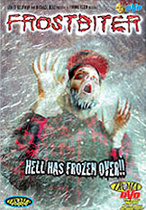Our editor-in-chief Nate Yapp is proud to have contributed to the new book Hidden Horror: A Celebration of 101 Underrated and Overlooked Fright Flicks, edited by Aaron Christensen. Another contributors include Anthony Timpone, B.J. Colangelo, Dave Alexander, Classic-Horror.com's own Robert C. Ring and John W. Bowen. Pick up a copy today from Amazon.com!
The Fly II (1989)
When Brooksfilms (yes, Mel Brooks' company) decided it was time to hatch a sequel to The Fly, Brooks championed perhaps the best alternative to the original's director, David Cronenberg, namely Chris Walas, The Fly's creature and make-up effects maestro.
Effects people often make good directors, especially for effects-heavy horror and sci-fi films, like The Fly II. In fact, in many ways, this film is to its predecessor as Aliens is to Alien, except that unlike Alien, which I feel is generally overrated, The Fly outshines its sequel.
Walas picks the film up shortly after the events of The Fly (which you should watch first) - nine months later, to be exact, with Veronica Quaife (this time played by someone other than Geena Davis, who said she didn't want to take a small cameo that basically consisted of kicking and screaming) giving birth to the Brundlething's (Seth Brundle -- The Fly -- played by Jeff Goldblum in the original) child. Of course the pupae picked up dad's genetic signature, since that was the path of least resistance to enable a sequel. We deduce that Brundle's employer, Bartok Industries, has discovered the events relayed in the first film and since Quaife dies while laying her egg, they now own the newborn Martin Brundle.
Martin is told that he has an accelerated growth syndrome. He is raised in a Bartok Industries lab, under surveillance, until he becomes a sexually mature adult at the age of five (played by Eric Stoltz from this point forward). He has the usual fight for independence, and his adoptive father, Mr. Bartok, gives him his own pad, plus a job working on his father's teleportation technology, which Bartok Industries just can't get to work correctly. The Fly II concerns (both literally and as subtexts) the quandary of ethical issues surrounding this premise and to ensure that we have a horror film, the consequences of Martin's discovery of both his true nature and the true character of his "family."
This was Walas' first time to bat as a director (and unfortunately one of his only times -- he seems to have taken a hiatus for most of the 90's) and although 20th Century Fox gave him control, there were arguments about the script which resulted in a cavalcade of scriptwriters (including an uncredited Walas as well as both Frank Darabont and Mick Garris) and a plethora of subplots. The complex premise is one of the results, but Walas deserves praise for turning what could have been a complete mess into a complex, focused meditation on corporations, "mutant rights and responsibilities," and in the vein of The Fly, romance and a criticism of using technology to play God.
As Aliens to The Fly's Alien, Walas involves a parade of characters and a lot more bombast and blatant special effects. The Fly II is more traditionally gory, and less Cronenberg-queasy, but the effects work just as well. One nice idea, which Walas credited to a request by Stoltz, was for the fly to emerge through an increase of stringy, sticky matter that builds into a cocoon, rather than Goldblum's molting transformation. Cronenberg is undoubtedly a master of a certain atmospheric approach to "gore," which is usually "disturbing biology" and "technobiology" in his case, but Walas, while his approach necessarily has a different mood, achieves some marvelous biological creations of his own-principally the full cocoon.
Stoltz and his love interest, Beth (Daphne Zuniga), receive 80% of the screentime, and both are excellent performers. The only actor returning from The Fly is John Getz as Stathis Borans, which makes sense since he's really the only surviving character (although it seems as if they may have had Quaife play a bigger role if Davis would have committed). Although Borans is still a pain in the butt here, he also shows a darkly comic side and Getz' presence provides a quality direct link to the first film.
More so than The Fly, The Fly II tries to delve a bit deeper into science fiction in its use of teleportation. We see a more practical approach to the renewed attempt to overcome the inanimate to animate teleportation barrier, and at least a token attempt to give somewhat of an explanation for the problem. It still falls far short of dealing with the premise in a scientific way, but the way the dialogue is laid out sounds convincing if you don't analyze it for Physics Today.
Like The Fly, the real attraction is to horror fans, and Walas delivers admirably. The Fly II isn't the goriest movie you'll ever see, but there's enough character development that when you see a scientist suspended upside-down over a pool of blood, you feel something for them, rather than just marveling at how cool the effects look. That combination of elements makes for a great film that is almost as good as the original, and for some who aren't huge Cronenberg fans, such as my wife, who finds him a bit too nauseating, and who tend to prefer big Hollywood extravaganzas (again, my wife is an example), The Fly II may actually be preferable.
Trivia:
Keep an eye out for a cameo by The Shape of Rage, a collection of essays on the works of David Cronenberg.








